

Evaluation Resource Material. S Jimmy Smith on farm animal diversity for more sustainable and resilient global food systems. Jimmy Smith, director general of the International Livestock Research Institute (ILRI), this week made a short presentation at the annual meeting of the Food Forever Initiative held in Wilmington, Delaware, 23–24 Sep 2018.
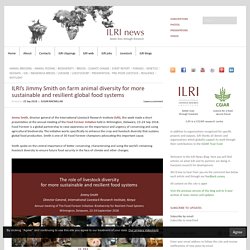
Food Forever is a global partnership to raise awareness on the importance and urgency of conserving and using agricultural biodiversity. The initiative works specifically to enhance the crop and livestock diversity that sustains global food production. Smith is one of 30 Food Forever champions advocating this important cause. Smith spoke on the central importance of better conserving, characterizing and using the world’s remaining livestock diversity to ensure future food security in the face of climate and other changes. Why care about livestock? Livestock are critical for food and nutrition security, and thus to achieving SDG2 on zero hunger.
Achieving sustainable and resilient food systems worldwide will be impossible without the livestock sector. How Do You See the World Around You? Do you view the glass as half-full or half-empty?

I hope you said “neither” — it’s never good to see the world through a single filter. The fact is, every gear in your car does something different. What would happen if you got stuck in neutral? The same can be said of the way that you view things. This is How Great Leaders Are Constantly Improving. Want to Innovate? Science Says, “Be Mentored!” Seeing the figure through the ground. Models can give us a place to start to have a conversation in order to develop shared understanding.

Mental models are one of the five disciplines of a learning organization, according to Peter Senge. I have frequently used the model of the Laws of Media developed by Marshall and Eric McLuhan which state that every medium (technology) used by people has four effects. Every medium extends a human property, obsolesces the previous medium (& makes it a luxury good), retrieves a much older medium, and reverses its properties when pushed to its limits. These four aspects are known as the media tetrad. Lecture 9 cross cultural teamwork. Study Reveals That A Bad Boss Can Make Employees Sick. How to Work for a Leader You Don't Believe In. HBRMulticulturalteamsjournalarticle. How to manage multicultural teams. A generation ago, most organisations employed a workforce that was representative of their geography.
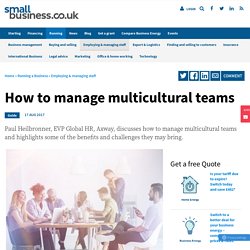
Today, the world is much smaller – we live in a global economy that is supported by ever-evolving technology which means a multicultural workforce is more common than not. Thankfully. Diversity in the workplace can be explored from several perspectives. Some consider it with academic or historical context, others debate the politics that sometimes surround it, and nearly everyone can contribute personal experiences. 4 Best Strategies for Managing a Multicultural Team. More often than not, business teams today are multicultural and remotely managed employees or freelancers are often international.
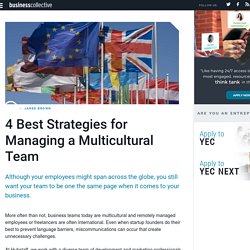
Even when startup founders do their best to prevent language barriers, miscommunications can occur that create unnecessary challenges. Chap005 6. 5 Essentials To Managing Multicultural Teams. “The potential for misalignment or different expectations goes up exponentially when you have people coming from different cultural backgrounds,” says consultant David Livermore, founder of Cultural Intelligence Center, a cultural intelligence consultancy, and author of Driven by Difference: How Great Companies Fuel Innovation through Diversity.
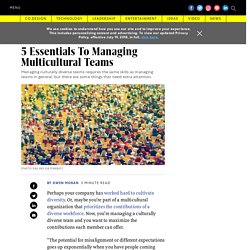
While managing culturally diverse teams requires the same skills to manage teams well in general, there are some particular areas that may need attention, he says. Buurtzorg's Healthcare Revolution: 14,000 Employees, 0 Managers, Sky-High Engagement. A 2×2 Matrix to Help You Prioritize the Skills to Learn Right Now. Executive Summary The modern worker has very little time for learning, and yet continuous learning is vital for anyone who wants to maintain their edge.
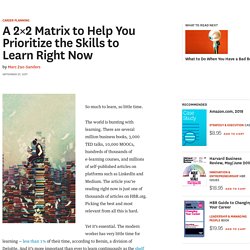
I Cut My Weekly Goals In Half And Got Twice As Much Done. We live in the age of FOMO, which extends beyond possessions and experiences to achievements.

I like to think that I don’t fall to those traps, but the truth is, I do. When I think about what I want to have achieved by the end of the year, month, week, or day, I always try to do more than what I can realistically handle, and then feel disappointed when I’ve only achieved two out of eight. A primer on creativity and innovation. The Test Every Great Leader Must Pass. Are you a good leader?

A great leader? How can you even know? You can take the test…….. Most leaders are too busy to spend much time reflecting on that question, but it really is important to check in once in a while—especially if results, achievement and excellence are important to you. Whether you’re a CEO, a vice president, director, team leader, neighborhood association leader, or parent, you can become a much more effective leader if you keep yourself on track. Leading change: The nonsense of urgency – Woodland Decay. Post in 40 words Creating urgency has become synonymous with leading change to the detriment of individuals, organizations, and societies.
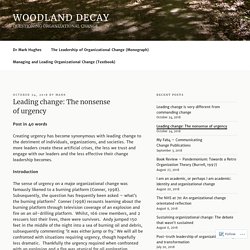
The more leaders create these artificial crises, the less we trust and engage with our leaders and the less effective their change leadership becomes. The Reflective Practitioner a case study. How lab heads can learn to lead. New principal investigators (PIs) tend to be thrust into a role that includes administration and management, budgeting, lab infrastructure, mentoring and — perhaps most difficult — shepherding junior scientists to achieve their full potential. Many researchers receive little training in leadership skills to help them adapt. And the problem is not limited to just new PIs. In Nature’s 2017 survey of PhD students, one-quarter of the respondents were dissatisfied with their adviser’s guidance on research, and only one-third said that their supervisors gave useful advice about non-academic careers.
Nature asked leadership experts what lessons other industries can offer to help scientists become more-effective PIs. PETER HIRST: Treat science like a business Associate dean of executive education at the Massachusetts Institute of Technology (MIT) Sloan School of Management in Cambridge. ACIAR Gender Equity Strategy. How To Survive a Sociopath Boss. Office Politics Getting You Down? Here's How to Survive... and Thrive — Alli Polin. Office politics are like a dirty word. We say it while cringing and it’s usually accompanied by a barely perceptible eye roll. Often, when people are asked how they describe office politics, the first word that comes to mind is painful. Oh, and stressful. Not to mention nasty… Quick! Australian Research Council's (ARC) Centre of Excellence for Climate System Science. Session 18 Action plan and John Leslie case study. Section 16 Managerial Communication (resource ideas)
Session 16A Meetings make the world go round (or mad) Session 15 solutions or improvements. Session 14 Review of Simulation experience. Session 13 Simulation 2. Session 12 Simulation. Session 11 Evaluation and PLanning. Session 10 Program Management and Finances. Session 9 Project Management. Session 8 Strategic Planning Essentials. Session 5 Time management. Session 5A some thoughts about careers. Session 5 Individual Delelopment Plan (Background)
Session 4 Contemporary Issues and Global Drivers. Session 4 Group Work. Session 2 3 6 7 Workbook. Session 2 3 6 7 Presentation. Session 1C working across culture (Resource material) Session 1 Group Exercise working in different cultures. Session 4 Group Work. Session 2 3 6 7 Workbook. Session 2 3 6 7 Presentation. Session 2 3 6 7 Presentation. Session 1C working across culture (Resource material) Session 1 Group Exercise working in different cultures. Session 1A Managing (Background material) Sapienza 2005 R&D Management. Final Penang 3 Program. Circular 2 for Penang3. Yes, eating meat affects the environment, but cows are not killing the climate. As the scale and impacts of climate change become increasingly alarming, meat is a popular target for action. Advocates urge the public to eat less meat to save the environment.
Some activists have called for taxing meat to reduce consumption of it. A key claim underlying these arguments holds that globally, meat production generates more greenhouse gases than the entire transportation sector. However, this claim is demonstrably wrong, as I will show. And its persistence has led to false assumptions about the linkage between meat and climate change. My research focuses on ways in which animal agriculture affects air quality and climate change.
Setting the record straight on meat and greenhouse gases A healthy portion of meat’s bad rap centers on the assertion that livestock is the largest source of greenhouse gases worldwide. According to the U.S. Yes, eating meat affects the environment, but cows are not killing the climate.